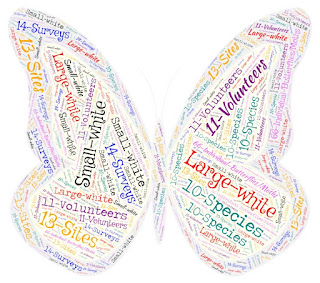We've had a busy summer this year with our Big Balsam Bash, Open Garden Square event and butterfly counts....
 |
| If you go down to the woods today... |
 |
| ...you'll find people trying to avoid getting stung by nettles while pulling balsam |
The 2018 Big Balsam Bash happened on the 2nd of June, we had a fantastic turn out with volunteers from a Geocashers group organised by a wonderful alumni of KU and geocasher Bev, local volunteers, students and volunteers from KUBAG and Environment Trust.
 |
| Lunch time photo op |
 |
| water testing with Thames 21 |
Elmbridge is full of Balsam, our never-ending task was made worthwhile thanks to the positive feedback from local site users.
 |
| Pulling out plants as bigger then the volunteer! |
 |
| A Buff Ermine moth (Spilosoma luteum) found emerging on vegetation - he was moved to safety to continue hardening his wings |
The other teams doing bashes across the catchment had a great turn out too with the Lower Mole tacklingthe Balsam where it first appears on the Hogsmill River. Without controlling this area and reducing the inflow of seeds into the system, our sites further downstream would continue to have balsam introductions if we ever were to get to a time when we had cleared all of the balsam on our sites closer to Kingston – Thank you.
We hope to be back in 2019 – keep your eyes peeled for dates closer to April/May 2019.
 |
| OGSW on the grounds of Dorich House Museum |
The Open garden Square event this year was ‘pear’ed back to the orchard at Dorich House.
 |
| Cakes and refreshments offered in return for donations to the Student Hardship fund. |
A lovely sunny day saw 70 visitors come through the gates, drawn in by attractions in the Museum, the Orchard and the wonderful Surbiton Yatai project.
Some of the visitors may not have expected to be helping us with our netting experiment when they planned in their visit. as we attempted to protect part of the harvest for us, while allowing wildlife access to the majority.of fruit.
 |
| A lovely pair of visitors help us experimentally net our apple tree |
Unfortunately reports from the site team said that while this seemed to work for the whole of July, at some point we had a clear out from within the net, where it may have come loose… pictured below-
 |
| The usual suspects |
The squirrels on the site have a bit of a Rambo reputation…we’ll be looking at other methods to see if we can somehow carve out a small harvest for ourselves next year – any suggestions (of the non-lethal, non-pesticide variety) would be most welcome.
 |
| Count results |
We managed to get the butterfly count completed this year, more of a straight rather than a royal flush as we were short by 3 sites for a full house.
The number of butterflies and moths seen this year was down by half compared to 2017 (66 individuals compared with 133 last year…However that drop should be looked at in context of the survey conditions - despite the alarmingly dry summer throughout July, the majority of our surveys could only be completed during the last week of the BBC in August – (remember when the rains finally came?)...
 |
| Speckled wood (Pararge aegeria) hiding amongst the leaves at Seething Wells |
Regardless of the overall weather conditions, each of the surveys were conducted during appropriate weather windows.
Compared with 2018, a decrease in the number of species was observed, with a total count of 10 identifiable species this year compared with 18 in 2017.
 |
| Sneaking up on a butterfly as it flutters by is hard to do! |
Our most common species across 11 of our 14 surveys was the Large White. Tolworth court came out top with the number of species seen with 5 out of the 10 we saw this year, but the numbers we low with only 1 of each species.
 |
| The amazing community growing space at the KU Nursery - cared for by the staff and kids at the nursery... |
 |
| ...a source of veg for the kids, and an oasis for wildlife |
Our second highest site for number of species was Knights Park with 4 species, however this site and the riverside planting won top trumps for the number of individuals observed. Thanks to the clouds of whites seen over the river planting, 15 individual butterflies seen during the survey.
 |
| Male common blue (Polyommatus icarus) at coombehurst meadow - fluttering around just after a short summer shower |
 |
| Female common blue (Polyommatus icarus) at coombehurst meadow |
When comparing the results from last year and this year, it shows that while one off nation surveys are vital for getting as many people as possible surveying site, which provides important baseline snapshots, esp. for areas which aren’t normally surveyed. It doesn’t beat long term monitoring for identifying more accurate data for species presence/absence and numbers on site.
In 2018 we had a lag in our survey efforts during the summer survey season. We're hoping to get this galvanised again next year, so if you are interested in helping to survey our sites at Kingston hill, Knights Park and Tolworth Court more regularly (weekly or fortnightly) for Dragonflies, butterflies and moths, please contact me on biodiversity@kingston.ac.uk
That's all for now folks, take care until next time.



No comments:
Post a Comment